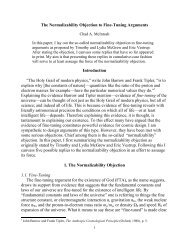Theism and Explanation - Appeared-to-Blogly
Theism and Explanation - Appeared-to-Blogly
Theism and Explanation - Appeared-to-Blogly
Create successful ePaper yourself
Turn your PDF publications into a flip-book with our unique Google optimized e-Paper software.
Potential Theistic <strong>Explanation</strong>s 87<br />
fl ap tagged with an instruction not <strong>to</strong> breathe while you eat, or the<br />
organs of generation not just next <strong>to</strong> but partially carrying the organs<br />
of excretion, or redundant bits of ana<strong>to</strong>my than can become infected<br />
<strong>and</strong> kill their owners, or permanent vulnerability <strong>to</strong> large numbers of<br />
invasive life-threatening organisms, or cells that constantly mutate in<br />
potentially life-threatening ways, or the origin of the optic nerve slap<br />
in the middle of the retina, or. . . . <strong>and</strong> so endlessly on. . . . Intelligent<br />
design? Look in a mirror for the horse-laugh answer <strong>to</strong> that one. 27<br />
As one might expect, the force of such suboptimality arguments is a much<br />
discussed issue in the intelligent design literature. But the discussion is hampered<br />
by a failure <strong>to</strong> think clearly about the structure of theistic explanations.<br />
Proponents of suboptimality arguments write as though theistic explanations<br />
were simple causal attributions, merely attributing some feature of the world<br />
<strong>to</strong> God. Their suboptimality argument runs as follows.<br />
(1) If God is responsible for this apparent design, we would expect it <strong>to</strong><br />
be perfect.<br />
(2) It is not perfect.<br />
(3) Therefore God is not responsible.<br />
This implies that a theistic explanation merely attributes some fact <strong>to</strong><br />
divine action, <strong>and</strong> I have argued that an explanation of this form would<br />
lack empirical content (3.2.3). And couched in this form, a suboptimality<br />
argument is <strong>to</strong>o easy <strong>to</strong> defeat, for it is far from clear what “perfection” in<br />
this context might mean.<br />
Even Gould’s “p<strong>and</strong>a’s thumb” argument suffers from this weakness.<br />
Gould argues that the design of the “thumb” could have been more effi cient<br />
than it was. You would expect better of an omnipotent, omniscient, <strong>and</strong><br />
morally perfect crea<strong>to</strong>r. I have already argued that this is the correct kind<br />
of question <strong>to</strong> ask. But it needs further specifi cation. For effi ciency must be<br />
measured against some goal, <strong>and</strong> Gould never specifi es what that goal might<br />
be. After all, the “thumb” in question is quite workable. So what does he<br />
object <strong>to</strong>? That it is apparently cobbled <strong>to</strong>gether? Well, that might provide<br />
evidence of its evolutionary his<strong>to</strong>ry, but this is a different argument. It’s no<br />
longer a suboptimality claim. And if the “thumb” is somehow imperfect,<br />
is Gould implying that God should have created a perfect p<strong>and</strong>a? But then<br />
what would a perfect p<strong>and</strong>a look like? As Paul Nelson writes,<br />
given the conventional concept of the crea<strong>to</strong>r, there seem <strong>to</strong> be no limits<br />
on what is possible, nor any reason (short perhaps of logical contradiction)<br />
why one hypothetically possible p<strong>and</strong>a should be preferred, as a<br />
counterfactual ideal, <strong>to</strong> another. If “perfection” is limited only by the<br />
extent of one’s imagination, then specifying an ideal phenotype, for<br />
the p<strong>and</strong>a or any other organism, quickly becomes a fanciful exercise.<br />
Why couldn’t the crea<strong>to</strong>r have given p<strong>and</strong>as the ability <strong>to</strong> fl y? 28



